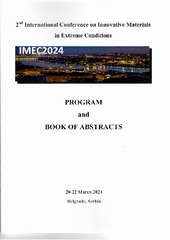Приказ основних података о документу
The influence of stainless steel particles reinforcement on the fracture toughness of glass-ceramic matrix composite
| dc.creator | Pavkov, Vladimir | |
| dc.creator | Bakić, Gordana | |
| dc.creator | Maksimović, Vesna | |
| dc.creator | Cvijović-Alagić, Ivana | |
| dc.creator | Maslarević, Aleksandar | |
| dc.creator | Rajičić, Bratislav | |
| dc.creator | Milošević, Nenad | |
| dc.date.accessioned | 2024-03-25T11:36:33Z | |
| dc.date.available | 2024-03-25T11:36:33Z | |
| dc.date.issued | 2024 | |
| dc.identifier.isbn | 978-86-7306-171-9 | |
| dc.identifier.uri | https://machinery.mas.bg.ac.rs/handle/123456789/7769 | |
| dc.description.abstract | The fracture of engineering materials is always an undesirable phenomenon, which primarily can endanger human lives, create economic losses, and lead to downtime and unavailability of mechanical parts. The main drawback that still prevents the broader use of ceramic and glass-ceramic materials is the tendency to brittle fracture due to extremely low toughness. Due to the appearance of cracks, the mechanical properties and structure of the material degrade irreversibly, which can lead to catastrophic failure of the mechanical element or construction. This drawback can be overcome by synthesizing novel composite materials with glass-ceramic matrix and metal reinforcement with improved fracture toughness. This research examined two materials: a glass-ceramic material and a composite material based on glass-ceramic-metal. The glass-ceramic material is obtained from andesite basalt powder, while the glass ceramic-metal composite is made from the glass-ceramic matrix of andesite basalt powder and a metal reinforcement of stainless steel powder in the content of 20 wt%. The aggregate of andesite basalt from Serbia was used as the starting natural raw material for obtaining the glass-ceramic matrix. The austenitic stainless steel powder of the commercial grade Surfit TM 316L was used as a reinforcement. Both materials were obtained using powder metallurgy, which consisted of the following phases: crushing of andesite basalt aggregate, sieving of the stainless steel powder, homogenization of powder and binder, cold uniaxial pressing of the powder, cold isostatic pressing of green compact and sintering as the final phase to obtain a high-density solid sample. The andesite basalt, and 316L stainless steel powder were characterized using a scanning electron microscope and X-ray diffraction method. The sintered samples of glass-ceramic and glass-ceramic-metal were characterized with an optical light microscope, scanning electron microscope, and Vickers hardness test. Based on the obtained results, it can bu concluded that the presence of metallic particles in the glass-ceramic matrix leads to a slight decrease in hardness while contributing to an increase in the materials fracture toughness by about 33% [1]. During crack propagation in the glass-ceramic matrix, different crack particle interactions were observed: crack stops, deflects, or bridgings when encountering the spherical metal particle. These interaction phenomena and mechanisms of crack propagation in the glass-ceramic-metal composite lead to an increase of crack propagation resistance. | sr |
| dc.language.iso | en | sr |
| dc.publisher | Vinča Institute of Nuclear Sciences - National Insittute of the Republic of Serbia, University of Belgrade | sr |
| dc.publisher | Serbian Society for Innovative Materials in Extreme Conditions (SIM-EXTREME) | sr |
| dc.rights | openAccess | sr |
| dc.rights.uri | https://creativecommons.org/licenses/by/4.0/ | |
| dc.source | Book of Abstracts - 2nd International Conference on Innovative Materials in Extreme COnditions | sr |
| dc.title | The influence of stainless steel particles reinforcement on the fracture toughness of glass-ceramic matrix composite | sr |
| dc.type | conferenceObject | sr |
| dc.rights.license | BY | sr |
| dc.identifier.fulltext | http://machinery.mas.bg.ac.rs/bitstream/id/19499/bitstream_19499.pdf | |
| dc.identifier.rcub | https://hdl.handle.net/21.15107/rcub_machinery_7769 | |
| dc.type.version | publishedVersion | sr |


